Reflections on the Gila River News Database
A Century in Print: Tracing the Newspaper Legacy of the Akimel O’otham
*You can find this project Database HERE
Table of Contents
What Is the Project?
Why Did I Do It?
What’s the Goal?
How Could You Use This?
How Did I Do It?
How Long Did It Take?
What Are Ways to Make the Database Better?
Final Thoughts
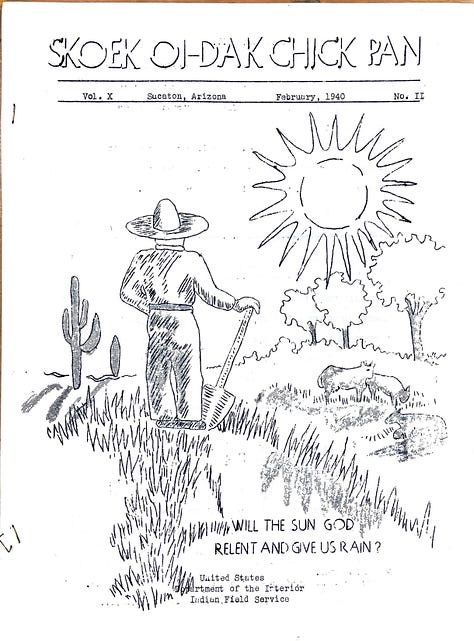
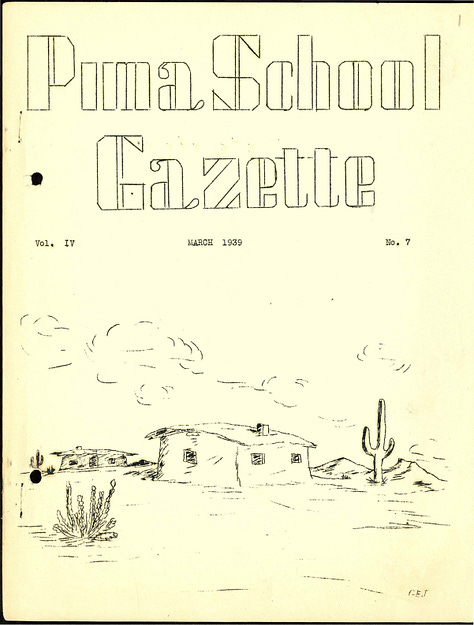
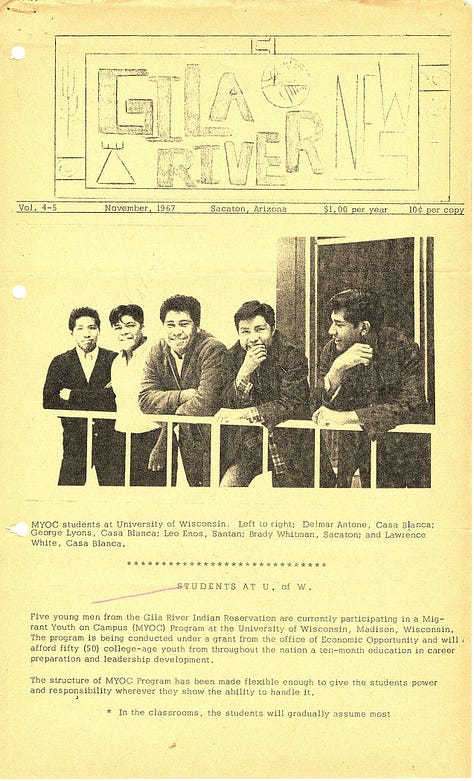
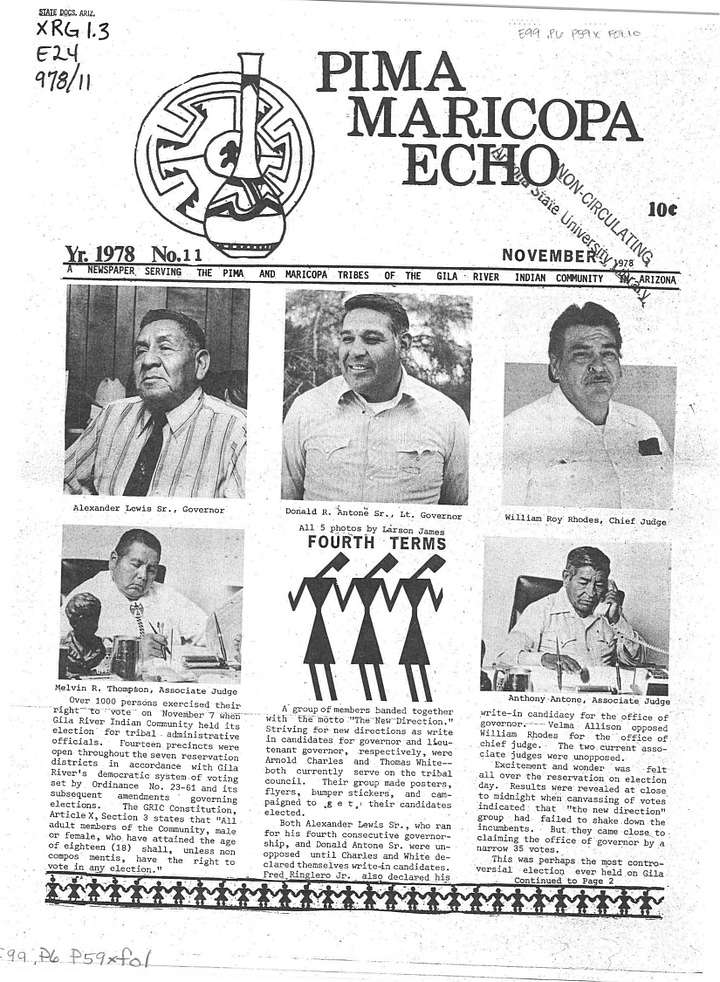
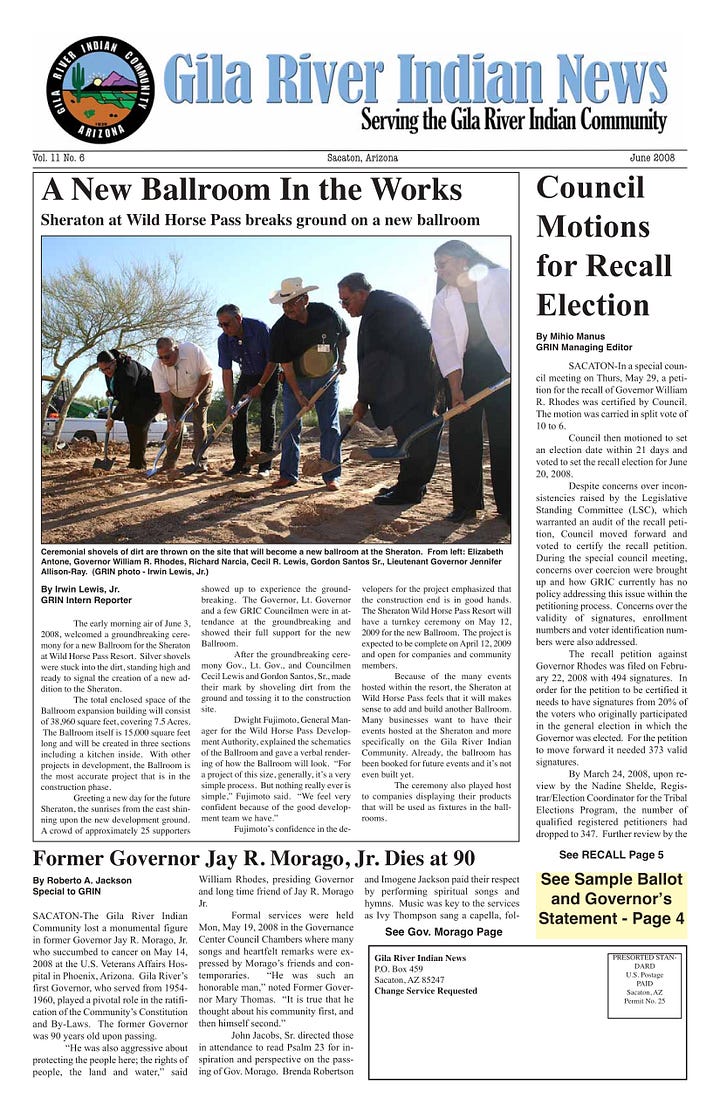
1. What is the project?
This is a database and listing of the various local newspapers of the Akimel O’otham, with a primary focus on publications from 1900 to the present. The goal is to track and organize the printed record of our community—something that, until now, hasn’t been systematically collected.
The database currently includes over 1,000 entries, indexing and inventorying the many papers that have come out of Gila River and surrounding O’otham communities. It includes issue-level details and points to what’s been digitized, what’s missing, and where copies might still exist
If interested in more information on the paper’s themselves, feel free to check out the other articles on my substack for more information!
2. Why did I do it?
This project grew out of another one I completed earlier—the Unofficial Action Sheet Database. That effort began with a simple goal: to make the decisions and history of our Community Council more accessible to our people.
As part of that work, I relied heavily on the Gila River Indian News (GRIN), especially for the Council Action Sheets published by the Council Secretary’s Office. But eventually, I reached the limit of what was available digitally. I had gone back as far as I could, and the project felt “good enough,” so I published it and moved on.
But along the way, I’d started a small side project: a list of “Interesting Stories.” You can still find it on the original Action Sheet database. It was a simple list of articles and stories that I thought were newsworthy, historically important, or just plain fascinating.
A lot of it was—honestly—just my opinion. But I was already reading through all these newspapers, so I figured I might as well mark the stories I wanted to come back to later.
That small side list eventually grew into something much bigger.
3. What’s the Goal?
The primary goal of this expanded project is to create a tool for research and education. A fair-use archive that helps preserve hard-to-find newspaper issues and minimizes the cost or effort needed for Community members to access our shared history.
4. How could you use this?
This tool serves a few purposes, depending on what you're looking for:
Read an Issue
The most obvious use: just read!
Go back and flip through old issues of our newspapers. Learn about O’otham history. See the stories, moments, and voices our ancestors felt were important to share. Or, use it to find where to look for a non-digitized issue if you want to go out and read from that time.
There's no better way to understand a time than through the words of those who lived it.
As as Inventory
This is also a way to gauge how much of our local news history has been preserved and digitized.
You’ll notice gaps—missing issues, unscanned papers, and materials held in outside archives. I haven’t visited or contacted every archive yet, but I’ve done a lot of legwork. You can scroll through and see where we’re strong, and where we’re still vulnerable. Many of these papers are at risk—undigitized, fragile, hard to access. It only takes one person with hot Cheeto fingers to lose something irreplaceable.
This inventory lets us track what exists, what’s available, and where it can be found.
Use It to Link Stories Together
This is where things get really interesting.
These newspapers aren’t just records—they’re links. I’ve used them to build out the Roots and Rivers database and to investigate dozens of stories that connect across time. These papers are tools to surface overlooked lives, trace family histories, and deepen our understanding of Community memory.
5. How did I do it?
This was a pretty involved process, so I’m breaking it into a few parts. Here’s a rundown of where I found these papers, starting from the most recent and working back in time.
Where I Found Stuff
You might be curious of how I found all of these old papers. I’m going to start from most recent to furthest back and give some information on how I found what I did.
The Gila River Indian News (1998 - Present)
At first, I didn’t even realize the GRIN had two distinct periods. That was something I learned as I dug deeper. This more recent era is the one I was already familiar with.
To start, I used custom Google search strings to find as many online issues as possible. A lot of digital copies are scattered across the main GRIC website, tucked away in PDF archives or embedded in server folders. I also came across a few other online repositories that had stored copies of the paper and related documents over the years.
For physical, non-digitized issues, I reached out to the Communications and Public Affairs Office (CPAO) at Gila River. They were incredibly helpful and allowed me to inventory their physical archive. I spent a few days there, going issue by issue, marking what they had available and noting what was missing.
The Gila River Indian News (1985-1998)
I found copies from this earlier era at both CPAO and the Arizona State Library. While doing this part of the inventory, I noticed a break in publication around 1998. That gap reflected a shift in how the Community structured and published the paper. That’s why I list this as a separate series—it represents a different chapter in the life of the GRIN.
The Pima-Maricopa Echo (1971-1982)
I first came across this paper at the ASU Library, where the Labriola Center was kind enough to digitize their collection. Many thanks to them for making that accessible. I also found additional issues at the Arizona State Library.
The Gila River News (1964-1970)
Now we’re getting into the fun stuff—the deeper history.
I found the Gila River News at the Huhugam Heritage Center (HHC). I had contacted them to share the progress I’d made so far and to ask if they had any issues of older community newspapers—digital or physical. That’s when I learned there was an even older paper than the one I’d been looking for.
For a long time, I thought the Gila River News was our original paper. But I was wrong.
The Pima School Gazette (1935-1947)
This find came from my late Uncle Darrell. When I shared this project with him, he got excited and went into the back room to grab some boxes.
Years earlier, while working with the Community, he had been around during a cleanup of a storage area. A bunch of boxes had been left out by the dumpster. Ever the dumpster diver, my uncle thought the newspapers inside looked important, so he rescued them. One of the workers apparently yelled at him for it—but if you knew Darrell, you can probably picture him standing there with his cup of coffee and cigarette, staring them down.
Turns out, his find was far more than just a pile of old newspapers. These boxes held an amazing piece of history: a glimpse into the short-lived Pima Central High School and its students, including the first graduating class of day-school kids in the entire country. Once again, Gila River was leading the way.
I’ve searched everywhere for other copies of this paper and found nothing. So, I allowed the Huhugam Heritage Center to digitize what we had, and I donated the physical copies to them for safekeeping.
Skoek Oidak Chick Pan (1930-1942)
Good Farm Work. I actually discovered this paper through a reference in the Pima Gazette. There was a mention of a new school attendance law that had been published in both the Gazette and something called the Chick Pan.
And I wondered—what is a “Chick Pan”?
I started searching online. And I mean searching. Hours and hours went by—nothing. No hits.
So I turned to the O’odham Learning Library (OLL). I ran a few searches through the digital books I had access to, and finally—finally—got a hit.
In Jennifer Bess’s Where the Red-Winged Blackbirds Sing, I found a reference to the paper, along with a photo of one of the covers. Her citation pointed to the Arizona Historical Society.
Once I knew where to look, it got easier. I put together some custom search strings and eventually found the publication in their archives—listed under a slightly different name.
That moment? Sweet, sweet dopamine. I was so pumped that I finally found something!
I traveled down to Tucson and spent a few days there, going through the collection and inventorying each issue. They have a pretty complete set and I’ve included what I could find there and in other archives.
Where I Found Stuff Pt.II
Beyond the excitement of actually tracking down physical copies, I also reached out to a few major archives: the Library of Congress, the Smithsonian, the Heard Museum, and others. I sent messages asking if they had any issues or collections that might include one or more of these publications.
I also used WorldCat to search library holdings across the country, trying to find anything else that might be tucked away.
In general, I didn’t uncover many large or complete collections. Most places only have the most recent versions of the Gila River Indian News, and anything older is hard to come by—maybe an issue or two at best. Nothing digitized.
Right now, my database includes the handful of places where I’ve found substantial collections. But as we grow our own physical and digital archives, there should be another round of outreach to these institutions and to GRIC members to find missing issues.
I’m hopeful we will recover missing issues, digitize them all, and have a complete collection someday.
Building the Database (finally)
This is the least exciting part. The database itself is built in Airtable. It’s a relational database, but nothing too fancy. Most of the hard work was in actually finding the materials—the database and inventory are just the scaffolding to hold everything together. Honestly, it’s kind of boring at this point. If you’ve seen any of my other projects you know what I did.
6. How long did it take?
I wish I had kept a better timer on this - but honestly I can’t say. I would guess hundreds of hours, for sure.
I think of the time in a few chunks…
Actual Database
As I said earlier, this was the simplest part. The database lives in Airtable, and I didn’t do anything too fancy—no automations, no complex formulas. I’ve built a lot of Airtables before, so this structure came together quickly. The real challenge was getting the data. This part just involved inputting and organizing everything. Of all the phases, this one probably took the least amount of time.
Online Searches
This part was deceptively time-consuming. I spent a lot of hours running searches through archives, tweaking search strings, and reaching out to institutions by email. The problem (and the joy) was that I kept discovering new things. Each new lead would send me in a new direction—another publication, another person, another archive to dig through.
On the bright side, this work added a lot of valuable entries to the O’odham Learning Library (OLL), so it paid off in more ways than one.
Visiting institutions
This was the first project that actually required me to—shudder—go places.
Most of my past projects have been more data-focused and computer-based, but this one had me traveling. I visited ASU, the Arizona State Library, and the Arizona Historical Society. I also spent a lot of time explaining the project to people—online, on the phone, and in person. I wanted to know if anyone had already done this work (to save myself some effort) or if they had leads on where I could find old papers.
This part took a lot of time—and a lot of gas money—but I learned a lot about how archives work and met some really generous and helpful people along the way.
Mentor Meetings
As usual, I leaned on mentors and friends in the Community for thoughts and feedback.
This project had me asking for input more than usual, especially when I needed help making sense of things. Elders helped fill in gaps, especially when it came to papers like the Pima Gazette—sharing memories, context, and community perspective that I couldn’t get from the records alone. I spent quite a few hours just talking with people, sharing what I’d found, and figuring out how best to present it all.
Reading
So. Much. Reading.
I’ve read through most of the digitized papers multiple times, taking notes and trying to understand the history, the people, and the patterns behind each publication. I also did some skimming and scanning through the undigitized issues where I could, which was slow but necessary. Even surface-level reading took a surprising amount of time.
7. What are ways to make the database better?
At this point, I think the database is in solid shape, but there are definitely areas that need more review and refinement.
Historical Accuracy:
One of the biggest needs is verifying the actual start and end dates of each paper. Many of the publications don’t have clear boundaries—I’ve had to make educated guesses based on volume numbers and how often they were published. A more detailed historical review would help clean this up.
Digitization:
It would be great to fully digitize all of these physical issues. Not only would that protect them from loss, but it would also make it easier for our people to access and read about their past.
A Better Front-End:
Look—I love data, but I’m not a design guy. I’d love to see someone build a more user-friendly front-end to make it easier to browse, search, and explore different issues.
Tags and Metadata:
More detailed tagging—by topic, person, place, etc.—would go a long way. It would help people find what’s most relevant to them and turn the database into a more powerful research and storytelling tool.
8. Final Thoughts
That’s about it. This isn’t the most complex project I’ve ever done, but it was definitely one of the most time-intensive.
I’ve been blown away by the feedback so far—from mentors, friends, and Community members who’ve had early access. It’s been incredibly rewarding to see people connect with this material. Sometimes a story in the paper will spark a memory, or match something someone heard from an elder years ago. That’s the magic of this work—watching history reattach itself to our lives.
I hope to keep building from here and improve the system over time. But for now, I think it’s in a good place. Thanks for reading—and enjoy exploring!
